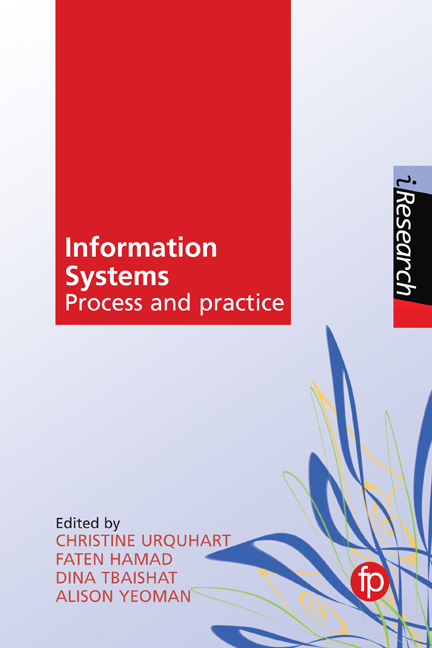Book contents
- Frontmatter
- Contents
- List of tables and figures
- Series editor's foreword
- About the authors
- 1 Introduction
- 2 Approaches to information architecture
- 3 Taxonomy testing for information architecture
- 4 The enterprise website and its information structures
- 5 Analysing activities, roles and processes
- 6 Libraries and the organisation of library processes – a history of operational research, and the use of process modelling
- 7 Using Riva process modelling to study book acquisition in academic libraries
- 8 Workflow analysis and process mapping in US academic libraries
- 9 A theoretical framework for designing and evaluating semi-structured document triage interfaces
- 10 Resource discovery case studies
- 11 Increasing social connection through a community-of-practice-inspired design
- 12 Methods for studying information provision, networking and communication in patient support groups
- 13 Health information systems: clinical data capture and document architecture
- 14 Producing systematic reviews and getting evidence to the clinician
- Index
9 - A theoretical framework for designing and evaluating semi-structured document triage interfaces
Published online by Cambridge University Press: 08 June 2018
- Frontmatter
- Contents
- List of tables and figures
- Series editor's foreword
- About the authors
- 1 Introduction
- 2 Approaches to information architecture
- 3 Taxonomy testing for information architecture
- 4 The enterprise website and its information structures
- 5 Analysing activities, roles and processes
- 6 Libraries and the organisation of library processes – a history of operational research, and the use of process modelling
- 7 Using Riva process modelling to study book acquisition in academic libraries
- 8 Workflow analysis and process mapping in US academic libraries
- 9 A theoretical framework for designing and evaluating semi-structured document triage interfaces
- 10 Resource discovery case studies
- 11 Increasing social connection through a community-of-practice-inspired design
- 12 Methods for studying information provision, networking and communication in patient support groups
- 13 Health information systems: clinical data capture and document architecture
- 14 Producing systematic reviews and getting evidence to the clinician
- Index
Summary
COMMENTARY: CHRISTINE URQUHART
The authors of this chapter (Fernando Loizides and Aekaterini Mavri) consider several topics that will be of interest to readers. A notable feature of it is that they back up their recommendations with references to research evidence. Instead of the usual ‘how to’ guidelines that can be found in manuals of information architecture, this chapter explains why designers should pay attention to certain elements of information architecture, for example, and refers to the research evidence. As the authors themselves emphasise, ‘user studies’ is a huge area of research, and it is impossible to refer to all the underpinning evidence. Another problem is that ‘user studies’ means different things to different disciplines with an interest in the information user.
The dialogue project (Dervin and Reinhard, 2006; Dervin, Reinhard and Shen, 2006) examined convergences and divergences in how three fields (library and information science, human–computer interaction and communication and media studies) looked at users and each other. The authors concluded that proper shared dialogue was desirable, but rare. The structures for commun - ication across research and practice, and between the disciplines, did not make for mutual understanding, easy discussion, or – frankly – the understanding of users or audiences that the researchers (and practitioners) truly want. Power, prestige and a dependence on ‘authority’ get in the way. With that in mind, and without taking away from the excellent presentation of research evidence in this chapter, you should remember that you may need to approach the evidence in this chapter (and other chapters in this book) with the sense-making questions set out in the introduction. What are my reactions to this evidence? What do I agree with? What do I disagree with? What else do I need to know or experience to make further progress with this topic?
There are several themes in this chapter. First, there is the idea of the semistructured document. The authors’ emphasis is on journal articles, patents and similar research study formats, and how these may be presented to readers to help them evaluate their contents quickly and successfully. There is considerable research on the difference in comprehension of reading text (usually linear text) on screen versus paper (e.g. Mangen, Walgermo and Bronnick, 2013).
- Type
- Chapter
- Information
- Information SystemsProcess and Practice, pp. 145 - 170Publisher: FacetPrint publication year: 2017



